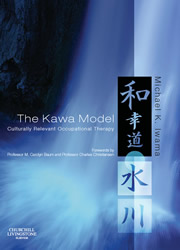The Kawa Model is
a new conceptual model of practice that heralds an important shift in the discourses of theory and culture in occupational therapy. The profession’s first substantial theoretical work to emerge outside of the West impels occupational therapy beyond its familiar bases of individual autonomy and agency, toward collective-oriented, interdependent views of human occupation. Infused with Eastern philosophical perspectives and world views, the Kawa Model brings nature and ecology to the profession’s evolving rational dialectic.
The Kawa (Japanese for river) model uses a familiar metaphor of nature as an effective medium to translate subjective views of self, life, well-being and the meanings of occupations. The familiarity of the metaphor – to both therapists and clients alike – and the ease with which its framework can be comprehended and applied makes this model an effective and highly relevant tool for an increasingly diverse global clientèle.
It is also
- an exposition of the profound relationship between culture,
theory, and knowledge - raised from occupational therapy practice, by practitioners for practitioners, through qualitative research methods
- illustrated with case studies from both Western and Eastern practice contexts
- developed through international collaboration.
The Kawa Model challenges occupational therapy students, practitioners, educators and researchers to comprehend their theory in a refreshing, critical light and consider how to advance their practice and profession toward a more inclusive and meaningful direction.
